Super Mario 3D World + Bowser’s Fury on Nintendo Switch
I’ll admit it. Super Mario 3D World never really got its claws into me when I played it on the Wii U back in 2013. I got a handful of worlds into Mario’s quest to save the Sprixie Kingdom before I moved onto other, more exciting things.
Having now revisited the game in 2021 on the Nintendo Switch, I can only assume that my experience the first time round was marred by my general dissatisfaction with the Wii U.
After 20+ hours across both Super Mario 3D World and the all-new Bowser’s Fury title packed in, I can safely say this is another first-party Nintendo title absolutely worth your time.
As I eluded to above, there are essentially two games in one here, so for the purpose of keeping things simple, I’ll be tackling one game at a time, before giving my overall thoughts to round things off. So, let’s dive into the familiar part of this dynamic duo, Super Mario 3D World.
Super Mario 3D World
Super Mario 3D World is the 2013 Wii U title all polished up for its debut on the Nintendo Switch. The story sees Mario, Luigi, Peach, and Toad stumbling upon a mysterious broken glass pipe. Upon fixing it, a Sprixie pops out and tells them Bowser’s been imprisoning their kind in glass bottles.
Of course, Mario and co. come to the rescue and dive down the pipe into the Sprixie Kingdom. From there on out, the story is largely forgotten about as you push through eight distinct worlds, catching green stars and seeking out the various stamps in each level along the way.
And immediately, you’re whisked through worlds of whimsy. Energetic orchestral scores and jazzy numbers accompany the vibrant colors on-screen, the iconic Goombas and Koopas standing tall in your way. Each level takes the classic toolbox of Mushroom Kingdom assets and finds a new and exciting way to use them in a 3D space.
Rather than being a true 3D adventure like Super Mario Odyssey, however, Super Mario 3D World is all about reaching the flagpole ‘Goal’ at the end of the level. But dispersed throughout the levels are three Green Stars you’ll need to collect to unlock later worlds and levels. There’s also a Stamp hiding in each level that can be used in the game’s Snapshot Mode (read: photo mode).
These stars and stamps aren’t just littered randomly throughout a level. A significant amount of thought has clearly gone into using each level’s unique design and traits to hide these collectibles.
It’s this level design that really stands out in Super Mario 3D World. And when it leans into that added dimension is when the game really shines. Bouncing between the foreground and background of a level, or spotting the shadow of a collectible, only to realize you have to walk towards the camera to actually find it.
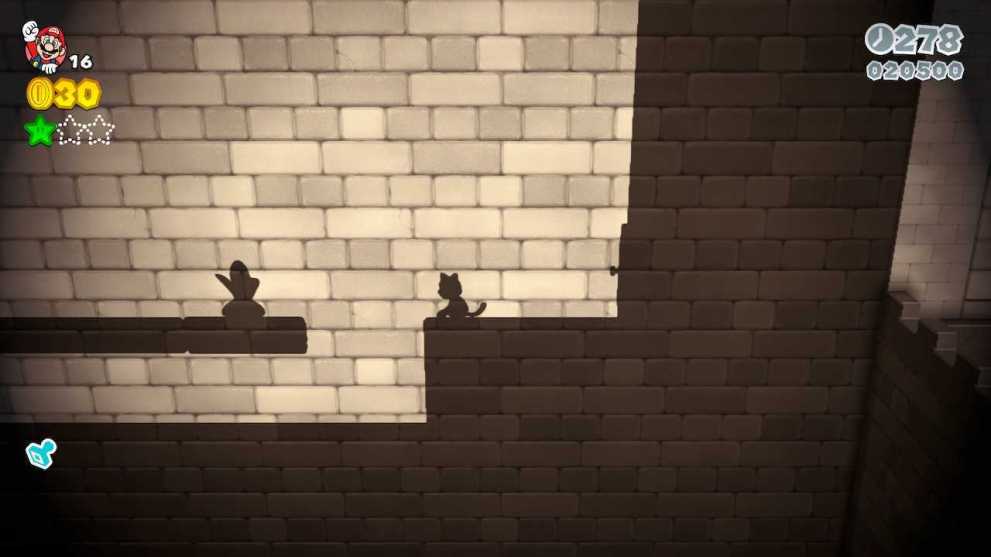
It’s basic stuff, but things you’d often overlook when pressing towards that finish line under time constraints. Going back to track these stars down became almost a compulsory action for me as I reached the later levels, and I had an absolute blast doing so.
The ingenuity in level design doesn’t stop there, though. Each of Super Mario 3D World’s four characters — Mario, Luigi, Peach, and Toad — have their own unique ability. Mario is your all-rounder, Luigi can jump higher and further, Peach can glide, and Toad is faster on-foot.
It makes replaying these levels even more of a blast than they already are. Alternatively, you can play through levels with a friend (or three) in local and online co-op multiplayer, which has worked a treat in our experience with the game.
Each player controlling a different character means you’ll be screaming and shouting at one another to “jump on that Luigi switch” or “get that Goomba while I grab the star.”
Super Mario 3D World doesn’t just stick to the one level ‘type’ though. There are Captain Toad levels that take the 3D Diorama-style gameplay from the standalone title Treasure Trove and offer up a nice break from the typical Mario platforming to be had.
There are levels comprised of ten, 10-second stages you need to complete in quick succession. Others have you riding atop Plessie, the dino-like creature with a penchant for water, gliding your way atop waves, avoiding obstacles, and pulling off massive jumps to nab that collectible.
To help vary up the gameplay further are the new power-ups that grant Mario new abilities. The bell that transforms the plumber into Cat Mario is front and center in Super Mario 3D World, allowing players to scratch their enemies to shreds and climb their way up walls to reach new platforms and areas.
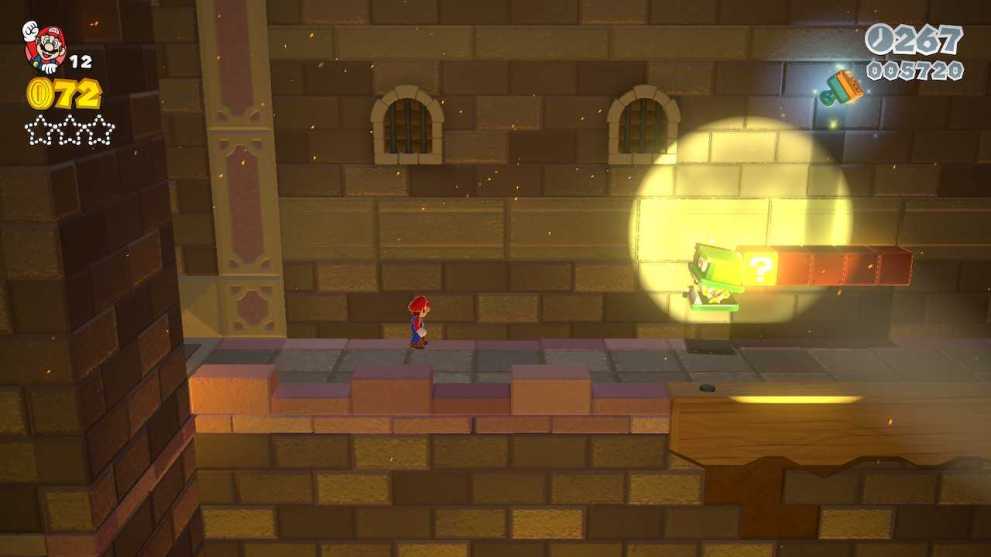
Levels that particularly stand out are those which used the Double Cherry power-up, duplicating Mario each time you grabbed one. Some required you split your clones into two groups to activate pressure switches, others you just needed to try and get them all through unscathed to get green stars on the way.
This leads me to another slight grievance with Super Mario 3D World. With beautifully-detailed environments to traverse, I often found myself wanting to have free movement of the camera.
A quick peek around a corner to see if there was a star hiding, or just swinging the camera around to get a better angle during intense platforming sections. Sadly, the Switch port remains faithful to the Wii U’s semi-fixed camera angles.
It’s the QOL updates that really let Super Mario 3D World down, especially given how excellent the Wii U version already was. While playing 3D World in handheld mode manages to retain 60fps, the visuals take a significant downgrade from playing in docked. It’s not a dealbreaker, but it does feel like another missed opportunity to give the game the polish it deserves.
Ultimately, Super Mario 3D World is still an excellent game. Despite not receiving the QOL improvements I’d hoped for after eight years, the gameplay is still fantastic whether playing solo or with friends, and the level design is inspired. It’s a satisfactory remaster of another of the Wii U’s lost treasures.
Bowser’s Fury
Where Super Mario 3D World plays it safe with its ‘traditional’ overworlds each with its own separate levels, Bowser’s Fury cuts up the blueprints and angrily launches them into the trash can. This is easily the most enjoyable part of this package, but it’s a real shame that it’s on the short side.
In Bowser’s Fury, Mario finds himself falling through a shadowy void sending him to the world of Lake Lapcat. Upon arriving, he finds Bowser mid-rampage, and past a few obstacles and platforming sections lies a Cat Shine. Grab that and Fury Bowser clears off for a bit. In that time Bowser Jr. explains that Bowser’s got so mad he’s out of control, but he’s unsure what caused it. Reluctantly, Bowser Jr. asks for Mario’s help to save his dad, and off on the adventure we go.
The game then opens up, allowing you to explore the first few islands on Lake Lapcat. This is where Bowser’s Fury really comes into its own. Each island is its own morphing, ever-changing treasure trove of platforming goodness and five Cat Shines.
What you have to do to earn these shines varies from reaching the lighthouse, collecting all the blue coins before time runs out, boss battles, finding five Shine Shards, blasting fury blocks, and more challenges that are unique to each island’s unique traits and characteristics.
Some islands feel confined with a larger emphasis on changing their layout between you getting one Cat Shine and returning to the beginning of the island to start the other.
For example, Fort Flaptrap was a personal favorite of mine in the early stages, which required me to navigate a series of switch platforms that changed whenever Mario jumped. It made climbing up what should have been a simple wall that little bit more difficult, causing me to retry the blue coin speed rush for it over and over again.
For the most part, given Bowser’s Fury uses the same assets as the Wii U port it’s packed-in with, Nintendo has done an excellent job of ensuring nothing feels overly familiar between the two.
But there are some exceptions — in particular a Cat Bully boss fight — that is literally the exact same in both titles. It felt a little disappointing that things weren’t mixed-up at all for the new title, but these moments were sparse in a world teeming with exciting and unique challenges to take on to earn Shines.
I’ll admit, I’m not normally one to replay something over and over if I don’t succeed in my first few tries, often putting it on the backburner and returning to it once I’ve further refined my platforming prowess. But Bowser’s Fury well and truly got its claws in me.
I’d often keep trying to get the same Cat Shine repeatedly, refining my approach and coming back for another go at the gauntlet. But even when everything did go horribly wrong, the freeform nature of Bowser’s Fury enables you to just duck out and move onto the next, regardless of whether you’re up in the clouds hovering over Lake Lapcat atop an island’s peak.
You can literally just jump back down in the water of Lake Lapcat, find Nessie — the Loch Ness monster-like creature — and swim over to the next island and Shine up for grabs.
So freeform is the nature of Bowser’s Fury, that it evokes a sense of relaxation that the other half of this package misses entirely. You can sit back and move the camera around, plotting out your path to that seemingly-out-of-reach Cat Shine, before slowly but surely pulling off some precise platforming to reach the golden glow of the Shine.
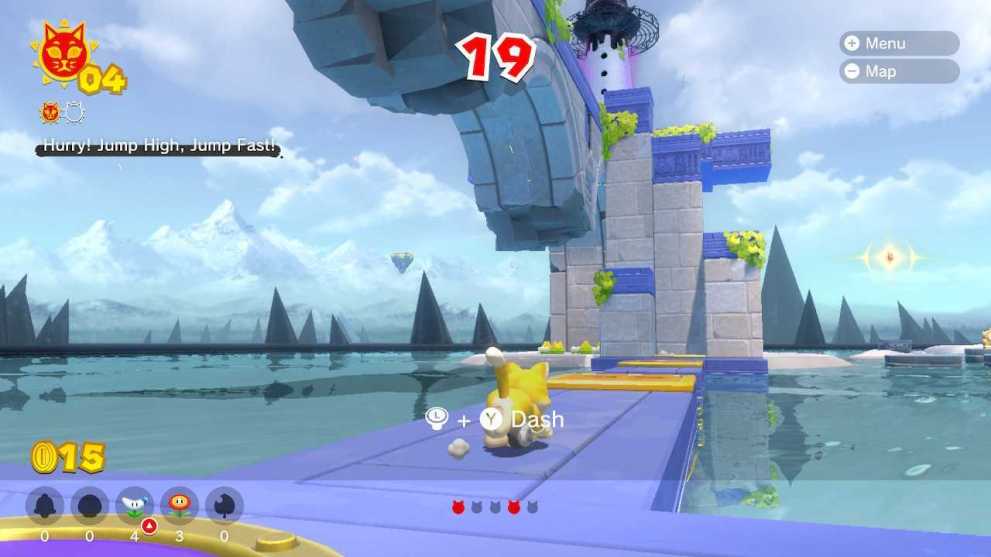
This sense of relaxation and freedom is at the heart of Lake Lapcat. The place feels like a lesser-known vacation spot of the Mushroom Kingdom, with a feline twist.
Enemies have cat ears, trees are shaped like cat heads, you’re collecting Cat Shines, and of course, there’s the giant Giga Bells, but more on those later.
Grabbing most Shines once you start a challenge and know what you’re doing takes about 10-15 minutes, making them the perfect thing to hop in and grab one or two of during a commute or before bed. It also has that ‘I’ll just get this one last Shine’ feel to it, which often led to me playing for hours longer than I intended to.
While the islands on Lake Lapcat themselves are these towering dioramas of platforming obstacles and little tidbits, the overworld does feel a little uninspired.
Traversing Lake Lapcat is done with the help of Nessie. The Loch-Ness-lookalike controls fine and is a great help, but I longed to be exploring a large open world of land, rather than water.
It allows for more to be hidden in the overworld, away from its island main attractions. Instead, Lapcat is a little devoid of anything else to see or do outside of getting Shines. Its watery-foundations inhibit opportunities to really push the boat out (pardon the pun), outside of the islands themselves.
That being said, by the time I’d reached the post-game content, there were markers littered all over my map, each one hinting at a Cat Shine’s hiding spot in the nearby vicinity.
In some ways, the game often feels like it has taken inspiration from Breath of the Wild. Bowser’s Fury does away with how you typically use power-ups in Mario titles.
Rather than you having to use one when you find it (or just the one stacking), the game allows you to stack up to five of each of the game’s six power-ups, for you to freely use whenever you wish. But it’s the way in which these are used to get some of the more challenging Cat Shines that really resonated with me.
Much like the Sheikah Slate’s Runes in Breath of the Wild allowed you to conquer the many different shrines across Hyrule, your power-ups unlock new options for you to explore.
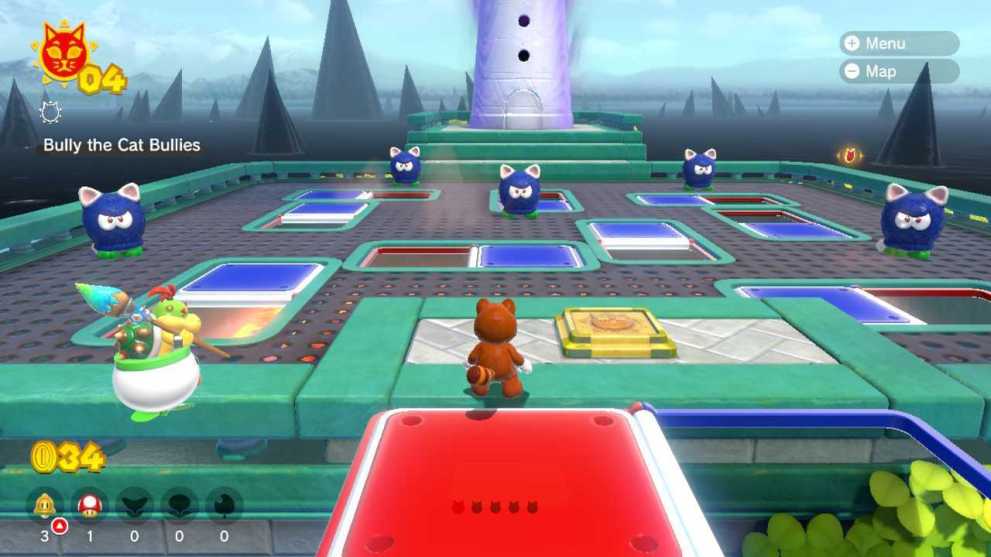
Alternative, faster shortcut paths open up for time trials thanks to Cat Mario’s ability to scale walls, or Tanooki Mario’s ability to hover. Combat challenges can be cut down to size with the Boomerang Suit or Power Flower.
But Lake Lapcat isn’t all cat-shaped trees and lollipops. Bowser’s Fury isn’t just the title of the game and part of the narrative, it’s a major, recurring part of the gameplay, too.
Every ten minutes or so, Giga Bowser will show up, completely transforming your tranquil surroundings into something straight out of a Mushroom Kingdom nightmare.
Fireballs rain down from the sky, new rocky pillars appear across the world, and of course, Bowser is stomping around the lake, trying to incinerate Mario at every possible opportunity.
Winds howl, rain pours, and the sky turns black. Friendly cats that once rubbed themselves up against Cat Mario turn evil, chasing after you as you hop, skip and jump your way to the next Shine.
Once impenetrable metal blocks can be incinerated by luring Bowser towards them and having him melt them down with his flamethrower-like breath, revealing more Cat Shines or hidden challenge levels that you’d otherwise miss.
All of this makes for an intense mix-up in the difficulty and the atmosphere, and there were times where there was absolute carnage unfolding around me, as I’m half-way up a towering island, and oh so close to the Cat Shine.
Bowser’s Fury transforms from a laidback platforming adventure to action-packed chaos. And while both offer up new ways to traverse the world and uncover its secrets, I did find myself rolling my eyes a little bit at the frequency of the ‘Fury’ sections.
Sometimes I just wanted to do some platforming, or access a Cat Shine I can only access when Bowser’s not in tantrum mode, or at least, is a lot easier when he’s not around.
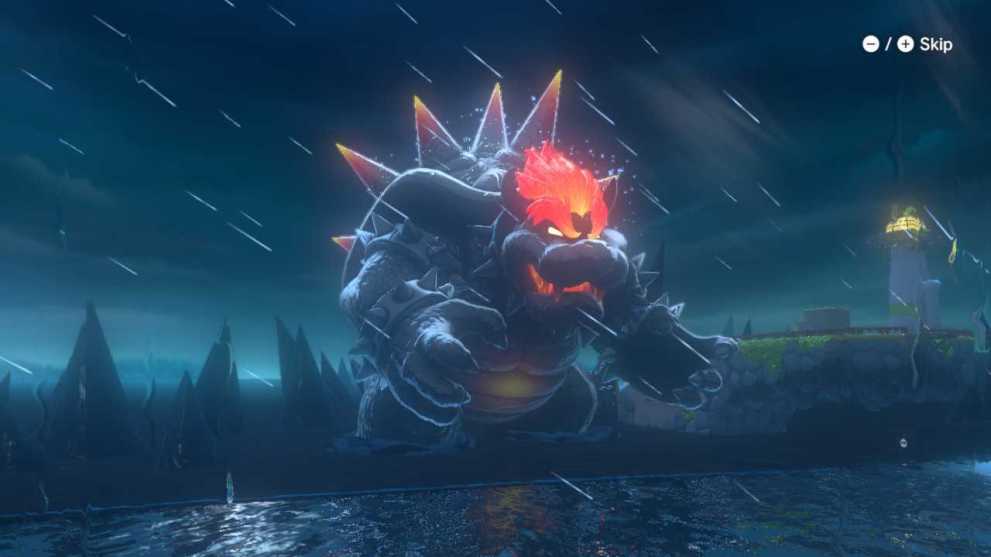
It is, however, during these sections where players can turn into Giga Cat Mario from the trailer. After getting enough Cat Shines, players can use the various Giga Bells across Lake Lapcat to transform into Giga Cat Mario.
What then transpires is one of the best Bowser boss battles I’ve ever played. Rather than transporting you to a different arena, it takes place right there in Lake Lapcat.
It’s a battle of the titans, with the various islands you once spent tens of minutes scaling now becoming perfect bits of cover from Bowser’s firey breath. Fancy flexing the claws of Giga Cat Mario? You can go in and swipe away, or wait for the right time and ground pound Bowser when he’s vulnerable. Each time you engage in one of these boss battles, they get more and more epic, culminating in an unforgettable final boss sequence.
These ‘fury’ sections are also where the game struggles a little in terms of performance. Playing with my Switch docked, there were no issues with the game running at 60fps, but playing in handheld, the framerate appears to drop to 30fps tops.
Alas, when Bowser reared his orange quiff-topped head during my handheld playtest, the framerate did stutter when things got very chaotic on-screen. It wasn’t massively detrimental, but if you’re a big handheld Switch player, this is certainly something to be aware of.
Honestly, my biggest complaint looking back at the time I’ve spent with Bowser’s Fury is that it was all over too soon. While I get that this is a pack-in bit of content alongside a port of a larger, fully-fledged Mario game, Bowser’s Fury felt like the segment I never wanted to end.
It’s relaxing, freeflow platforming with a hint of Breath of the Wild inspiration. It feels like the next step for full 3D Mario adventure platforming (think Odyssey), and honestly, I’m hoping this was a mere teaser of a much larger 3D Mario game in the pipeline that adopts this very same formula.
Bowser’s Fury is yet another example of Nintendo’s ingenious innovation to ensure its most iconic mascot remains relevant. Its shortcomings are both literal in terms of its duration and minor, with its iffy performance in handheld mode, and cookie-cutter copying from Super Mario 3D World. They’re so minor, though, that ultimately my biggest complaint is there isn’t more of it.
Super Mario 3D World + Bowser’s Fury offers two adventures’ worth of 3D Mario platforming action in one convenient package. Though Super Mario 3D World is a little limited in its QOL improvements, the game still offers over 80 charming levels of platforming action.
The real star of the show, however, was Bowser’s Fury, which innovates on the foundations laid by previous 3D titles, to provide some of the most enjoyable, open-world platforming I’ve had the pleasure of playing. This is a must-buy for Switch owners and Mario fans alike and is sure to tide you over the next couple of months.
Pros
Cons
Bowser’s Fury drops to 30FPS in handheld mode.
Bowser’s Fury is a little on the short side.
The ‘Fury’ sections in Bowser’s Fury can get a little frustrating.
